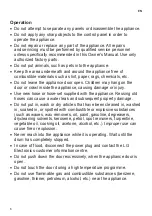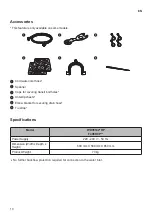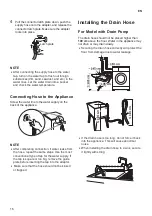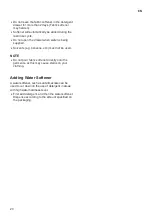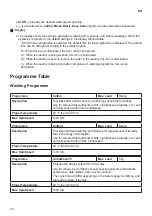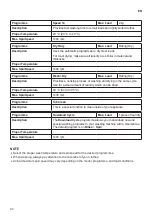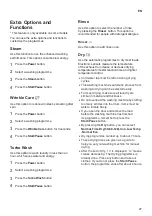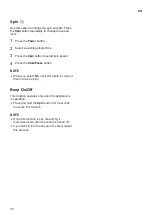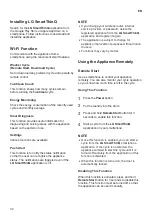
18
EN
NOTE
•
The dashes under the symbol give you
information about the type of fabric and the
maximum allowance of mechanical stress.
Checking the Clothes before
Loading
•
Combine large and small items in a load. Load
large items first.
•
Large items should not be more than half of the
total wash load. Do not wash single items. This
may cause an unbalanced load. Add one or two
similar items.
•
Check all pockets to make sure that they are
empty. Items such as nails, hair clips, matches,
pens, coins and keys can damage both your
appliance and clothes.
•
Wash delicates (stockings, underwired bras) in
a wash net.
•
Close zippers, hooks and strings to make sure
that these items do not snag on other clothes.
•
Pre-treat dirt and stains by brushing a small
amount of detergent dissolved water onto stains
to help lift dirt.
•
Check the folds of the flexible gasket (gray) and
remove any small articles.
CAUTION
•
Check if the laundry gets stuck between the
door and the seal, otherwise the laundry may
get damaged while washing.
•
Remove items from the flexible gasket to prevent
clothing and door seal damage.
Adding Detergents and
Softeners
Detergent Dosage
•
Detergent should be used according to the
instruction of the detergent manufacturer and
selected according to type, colour, soiling of the
fabric and the washing temperature.
•
If too many suds occur, reduce the detergent
amount.
•
If too much detergent is used, too many suds
can occur and this will result in poor washing
results.
•
If you wish to use liquid detergent, follow
the guidelines provided by the detergent
manufacturer.
•
You can pour liquid detergent directly into the
main detergent drawer if you are starting the
wash cycle immediately.
•
Do not use liquid detergent if you are using
Delay End
function, or if you have selected
Pre Wash
option, as the liquid may harden.
•
Detergent usage may need to be adjusted for
water temperature, water hardness, size and
soil level of the load. For best results, avoid
oversudsing.
•
Refer to the label of the clothes, before choosing
the detergent and water temperature.
•
Use only suitable detergents for the respective
type of clothing:
−
Liquid detergent is often designed for special
applications, e.g. for coloured fabric, wool,
delicate or dark laundry.
−
Powdered detergent is suitable for all types
of fabric.
Summary of Contents for F4V9RCP Series
Page 46: ...Memo ...
Page 47: ...Memo ...



